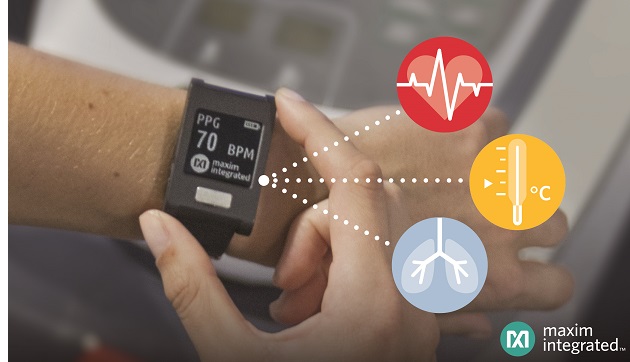Designers seeking to enable continuous monitoring of various health parameters can now quickly create unique, highly accurate wearable solutions using Health Sensor Platform 2.0 (HSP 2.0) from Maxim Integrated Products, Inc. This next-generation rapid prototyping, evaluation and development platform, also known as MAXREFDES101#, brings the ability to monitor electrocardiogram (ECG), heart rate and body temperature to a wrist-worn wearable, saving up to six months in development time.
When it comes to wearables, a wrist-based device is convenient for users to wear daily. However, it has been challenging to derive precise ECG monitoring from the wrist (most alternatives require a wearable chest strap). In addition, getting accurate body temperature typically requires using a thermometer at another location. Through its proprietary sensor and health monitoring technology, Maxim has overcome these challenges in the HSP 2.0.
Unlike other wearables, the data measurements collected by the HSP 2.0 can be owned by the wearer, alleviating data privacy concerns and allowing users to conduct their own data analysis. Also, because HSP 2.0 is an open platform, designers can evaluate their own algorithms on the board. In addition, the modular format is future proof to quickly accommodate new sensors over time.
HSP 2.0 includes the following products:
- MAX32630 DARWIN low-power microcontroller for wearables and internet of things (IoT) applications.
- MAX32664 ultra-low-power biometric sensor hub with embedded heart-rate algorithm.
- MAX20303 highly integrated and programmable power management solution designed for ultra-low-power wearable applications.
- MAX30205 human body temperature sensor with ±0.1 degree Celsius accuracy.
- MAX30001 ultra-low-power, single-channel integrated biopotential and bioimpedance analog front-end (AFE) solution for wearable applications.
- MAX86141 ultra-low-power optical pulse oximeter and heart-rate sensor for wearables.
Key Advantages for Designers:
- Fast Time to Market: Fully working hardware and firmware with companion watch casing cuts design and validation time by up to six months.
- High Accuracy: Only available solution to integrate clinical-grade ECG along with heart-rate and body-temperature measurements into a wrist-worn format.
- Arm Mbed Support: For efficient evaluation and rapid application prototyping, the Mbed environment provides a high level of abstraction to eliminate maintenance of software tools and provide an extensive library of open-source software.
“Patients and medical professionals are increasingly wanting more real-time exchange of accurate health data collected over an extended time frame, along with the ability to access this data from anywhere,” said Andrew Baker, managing director, Industrial and Healthcare Business Unit, Maxim Integrated. “Wearable and medical device manufacturers can turn to Maxim’s HSP 2.0 to create accurate, wrist-worn health monitoring solutions, shaving off up to six months of the typical development time.”








